Allosaurus

Allosaurus
The official Utah State Fossil
Scientific Name: Allosaurus fragilis means “strange, delicate reptile” in reference to what was thought to be peculiar, fragile back vertebrae at the time of its discovery.
Time Period: 157-150 million years ago, Late Jurassic
The Museum’s Allosaurus
The skeleton of Allosaurus, nicknamed 'Al', went on display in June 1963 and was the Museum’s first dinosaur skeleton. It was remounted into a new pose in 2013. The skeleton is 28 feet long and 6½ feet tall at the hips. The bones came from the Cleveland Lloyd Dinosaur Quarry, about 30 miles south of Price. This quarry has the richest concentration of Allosaurus in the world. At least 46 individuals ranging from juvenile to adult are represented by the 12,000 bones uncovered.
The Animal
Allosaurus is a carnivorous dinosaur that lived 83 million years before Tyrannosaurus rex. It had a long tail that was almost 60% of its entire length. This tail was a counterbalance to the heavy front part of the body over the hind legs. The tail probably also allowed Allosaurus to change directions rapidly while chasing prey by shifting the tail to the inside of the turn.

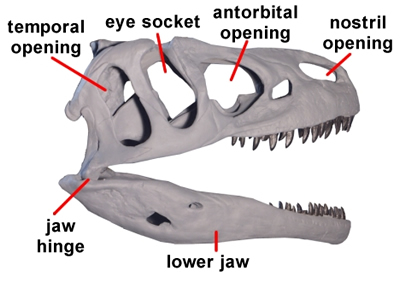
The skull of our Allosaurus is 28 inches long.
It has long, blade-like teeth that are serrated like a steak knife along the front and rear edges. These serrations allow the teeth to rip through skin and across muscle fibers. Just how powerful was the bite? By measuring the area for the jaw muscles on the underside of the skull and knowing the force of muscles, we can determine that the jaw muscles generated almost a ton of force. But, this force is concentrated on the tips of the teeth, so that means a typical bite using the teeth in the front half of the mouth - would create almost 6,500 pounds per square inch of force on each tooth! Not surprisingly, deep gouges have been found in other dinosaur bones from Allosaurus feeding.
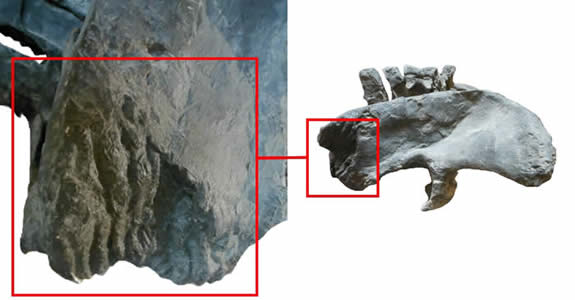
Unlike Camptosaurus, the Allosaurus teeth are set at the sides of the skull, meaning that Allosaurus did not have cheeks, and therefore, did not chew its food. All that it could do was bite and swallow.
The neck vertebrae have a ball and socket connection, which allowed the neck to swivel. However, the vertebrae also had a lot of ridges and heavily built spines for ligaments and powerful neck muscles. This powerful neck could pull the head back so that the teeth could rip large chunks of flesh to swallow.
The neck and the first four vertebrae of the back have cavities within them. These cavities are similar to those seen in bird vertebrae, where they are part of the breathing system. In birds, there are a series of pouches or air bladders throughout the body and some even extend into the vertebrae. It takes two breathes to pass the air through the body before it is exhaled. In the first breathe, the air goes into several air bladders or pouches in the back part of the body cavity. In the first exhale, the air moves to the lungs. With the next breathe, the air moves into the air bladders in the front of the body, and is finally exhaled from the body. Many paleontologists believe that the cavities in the vertebrae indicate that Allosaurus had a similar breathing system of air bladders.
Another remarkable recent discovery shows that Allosaurus and many other carnivorous dinosaurs had a V-shaped wishbone. In Allosaurus the wishbone is a rather delicate structure that spans the chest, although its purpose is unknown.
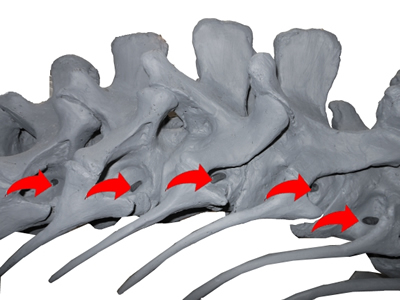
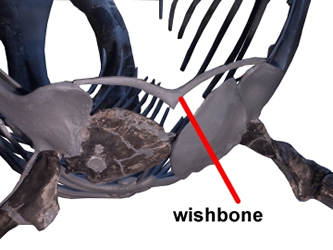
In flying birds, the wishbone is a spring that aids in flight by pushing the shoulder apart during the down stroke of the wings.
A study of arm motion showed that the Allosaurus shoulder socket did not allow the arms to reach forwards very far. Instead, most motion was backwards. This means that Allosaurus was not able to reach forwards to grab prey, but once it had grabbed the prey with its mouth, it could use the big meat hook claws to keep the prey from escaping. The hands of Allosaurus have three curved claws with the “thumb” having the largest.
The hind foot is very bird-like, with three long toes with raptor-like claws. These claws were used to hold the prey down while it ripped flesh with a backwards pull of its head. The first toe, the dewclaw, is small and does not reach the ground. Why Allosaurus kept it is unknown, but must be like the appendix in people, where the vestigial structure remains because it usually does not do any harm.
Allosaurus was a top predator in the Morrison ecosystem. Being so large, it probably preyed on almost any other dinosaur with the possible exception of large adult sauropods. Because Camptosaurus lacked any protective armor, it was probably easy prey. Surprisingly, we know that Allosaurus also preyed on Stegosaurus. The evidence from the Cleveland Lloyd Dinosaur Quarry includes plates with U-shaped bites taken from them and an Allosaurus vertebra with a puncture that matched the size and shape of a Stegosaurus spike. The Allosaurus survived the attack because the damage shows partial healing and regrowth of bone.
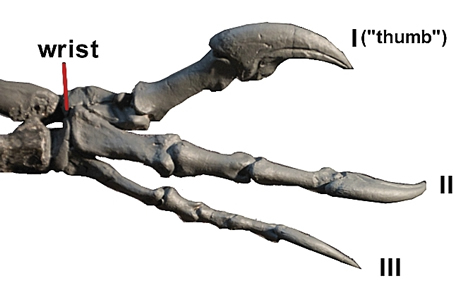

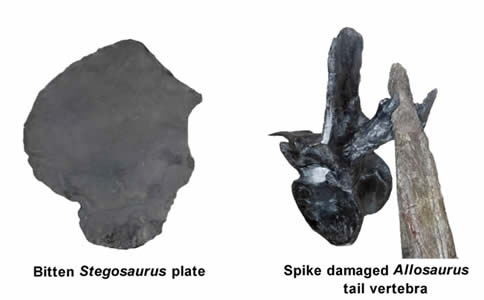

A possible egg of Allosaurus was found at the Cleveland-Lloyd Dinosaur Quarry. It was an abnormal egg with multiple shell layers. These layers indicate that the egg was not laid, but kept in the female’s body longer than normal so that shell was deposited several times. A similar situation can happen today in birds under stress, such as illness,starvation or crowding. For the Allosaurus, there must have been some sort of stressful situation in the region of the Quarry because of the high number of Allosaurus congregated there.

